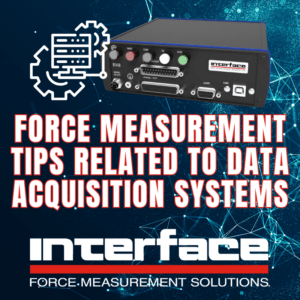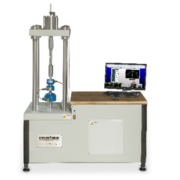Force Measurement Tips Related to Data Acquisition Systems
 A data acquisition (DAQ) system consists of hardware and software components designed to collect, process, and analyze data from various sources and convert it into digital format for further analysis and storage. Based on the growing requirements to gather more data faster, Interface continues to add to our line of data acquisition systems to use with our load cells, torque transducers, and multi-axis sensors. These systems are designed for comprehensive force and torque measurement data collection and analysis.
A data acquisition (DAQ) system consists of hardware and software components designed to collect, process, and analyze data from various sources and convert it into digital format for further analysis and storage. Based on the growing requirements to gather more data faster, Interface continues to add to our line of data acquisition systems to use with our load cells, torque transducers, and multi-axis sensors. These systems are designed for comprehensive force and torque measurement data collection and analysis.
Is more data, with easy integration and high accuracy, your objective? Working with our team of application engineers, we can assist you in pairing the best data acquisition system with your specific transducers. Considering the options, our team of experts offers these five essential bits of advice.
Data Acquisition Systems Tips for Test & Measurement
Select the Right Data Acquisition System
Choosing a data acquisition system compatible with your specific force measurement devices and application requirements is crucial. Consider factors such as sensor type, measurement range, accuracy, resolution, sampling rate (considering your over-sampling requirements), and connectivity options. In addition, the size and form factors can be critical to an application.
Proper Sensor Installation and Calibration
Proper sensor installation and calibration are critical for accurate force measurements. Follow the guidelines for sensor installation, including correct mounting, alignment, and wiring. Ensure that the load cell is calibrated according to established procedures and standards and that the calibration is regularly verified to maintain measurement accuracy. Proper sensor installation and calibration help eliminate potential sources of measurement errors.
Signal Conditioning and Filtering
Signal conditioning and filtering techniques are essential for optimizing the quality of the acquired force data. Signal conditioning involves amplification, offsets (zeroing), filtering, and linearization of the sensor output signal. Filtering techniques, such as anti-aliasing filters, IIR, or FIR, can help reduce noise and unwanted signals, ensuring accurate and reliable force measurements.
Data Validation and Analysis
Implement data validation techniques, such as range checking, outlier detection, and data integrity checks, to identify and correct potential data errors or anomalies. Analyze the acquired data using appropriate statistical and data analysis techniques to extract meaningful insights and make informed decisions based on the force measurement data. Be sure to select a force measurement device that is highly accurate and of superior quality.
System Maintenance and Calibration
Regular system maintenance, including sensor calibration and system validation, is crucial for reliable and accurate force measurements. Follow Interface’s recommendations for system maintenance, including sensor cleaning, inspection, and calibration intervals. Regular calibration and validation of the data acquisition system and force measurement devices help ensure the system remains accurate and reliable.
For additional information about Interface data acquisition solutions, watch the Unlocking the Power of DAQ webinar.
Popular Interface Data Acquisition Instruments
BX8 Data Acquisition Series
BX8-AS BlueDAQ Series Data Acquisition System with Industrial Enclosure
BX8-HD15 BlueDAQ Series Data Acquisition System for Discreet Sensors with Lab Enclosure
BX8-HD44 BlueDAQ Series Data Acquisition System for Multi-Axis Sensors with Lab Enclosure
Features & Benefits
- 8-Channel synchronized sampling + TWO encoder/pulse channels
- Strain gage, mV/V, ±10VDC, and PT1000 temperature inputs
- Internal calculation of axis load values for 6-axis sensors
- Active scaling of analog outputs according to internal calculations
- ±5V, ±10V, 4-20mA, and 0-20 mA outputs
- 48K samples/sec/channel, 24-bit internal resolution
- USB connection to PC, Includes graphing and logging software
- Excitation sense
- Strain gage Full, 1/2, and 1/4 bridge, including bridge completion
- TEDS compatible, ZERO button for 8-channel simultaneous tare, 16 digital I/O
- Galvanic isolation: Analog input, analog output, digital I/O, USB
- EtherCAT and CANbus/CANopen options
- Enclosure Options
BSC4 Digital DAQ Model
BSC4D Multi-Channel Digital PC Interface and Data Acquisition Instrument
Features & Benefits
- USB outputs
- Four independent channels
- For use with model 3AXX series 3-axis load cells
- It can be used with up to any four standard load cells (with mV/V output)
- mV/V, +/-5V, +/-10V, PT1000
- Strain gage quarter/half and full bridges
- 120, 350 & 1000 Ohm bridge completion
- Limit frequency 450 Hz
- Eight digital inputs/outputs
Use Cases for Data Acquisition Systems in Test & Measurement
Robotic Surgery Force Feedback using DAQ System
A biomechanical medical company wants to test its robotic arm’s force, torque, and tactile feedback for invasive surgery. The robotic arm mirrors the surgeon’s movements during surgery, and all haptic force feedback must be measured to ensure safety during invasive surgery. Several of Interface’s force and torque measurement products have been used on this robotic arm, including the ConvexBT Load Button Load Cell, SMTM Micro S-Type Load Cell, and the MRTP Miniature Overload Protected Flange Style Reaction Torque Transducer. Force results are collected when connected to the BX8 8-Channel Data Acquisition and Amplifier and viewed when attached to the laptop.
Material Tensile Testing using Data Acquisition Instrumentation
A customer wants to conduct a tensile force test on different samples and materials until failure. Materials include plastic, steel, or woven fabric. They want to measure tensile strength, yield strength, and yield stress. Interface’s 1200 Standard Precision LowProfile™ Load Cell is installed into the customer’s test frame. The tensile test is conducted, and force results captured by the load cell and extensometer are synced. These results can be displayed on a PC with supplied software.
Planetary Sample Collecting
As space exploration continues to grow and evolve, more robotic systems are created to collect samples of objects and materials on planetary surfaces. Robotic arms with sampling tools must be tested for scooping, drilling, and collecting samples. Interface’s Model 6A40 6-Axis Load Cell can be installed between the flange and the sample collecting tool. When connected to the BX8-HD44 Data Acquisition, the customer can receive force and torque measurements when connected to their control system using BlueDAQ software. Interface’s 6A40-6 Axis Load Cell could measure all forces and torques (Fx, Fʏ, Fz, Mx, Mʏ, Mz.) The BXB-HD44 Data Acquisition could log, display, and graph measurements while sending scaled analog output signals for these axes to the customer’s robot control system.
Learn more about your DAQ system options using Interface’s Data AQ Packs Guide.








